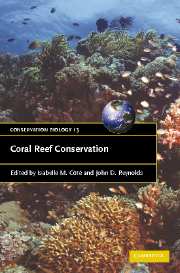Book contents
- Frontmatter
- Contents
- List of contributors
- Foreword
- Preface
- Part I Setting the stage
- Part II Uses and abuses: ecological and socio-economic issues
- Part III The way forward: tools and approache
- 9 New approaches to estimating recent ecological changes on coral reefs
- 10 Assessing the effectiveness of marine protected areas as a tool for improving coral reef management
- 11 Environmental impact assessment for coral reefs: advocating direct protective approaches
- 12 Time for a third-generation economics-based approach to coral management
- 13 Collaborative and community-based conservation of coral reefs, with reference to marine reserves in the Philippines
- 14 Education as a tool for coral reef conservation: lessons from marine protected areas
- 15 Adaptive institutions for coral reef conservation
- 16 Coral reef restoration with case studies from Florida
- 17 Redesigning coral reef conservation
- 18 Coral reef coda: what can we hope for?
- Index
- Plate section
- References
13 - Collaborative and community-based conservation of coral reefs, with reference to marine reserves in the Philippines
Published online by Cambridge University Press: 05 June 2012
- Frontmatter
- Contents
- List of contributors
- Foreword
- Preface
- Part I Setting the stage
- Part II Uses and abuses: ecological and socio-economic issues
- Part III The way forward: tools and approache
- 9 New approaches to estimating recent ecological changes on coral reefs
- 10 Assessing the effectiveness of marine protected areas as a tool for improving coral reef management
- 11 Environmental impact assessment for coral reefs: advocating direct protective approaches
- 12 Time for a third-generation economics-based approach to coral management
- 13 Collaborative and community-based conservation of coral reefs, with reference to marine reserves in the Philippines
- 14 Education as a tool for coral reef conservation: lessons from marine protected areas
- 15 Adaptive institutions for coral reef conservation
- 16 Coral reef restoration with case studies from Florida
- 17 Redesigning coral reef conservation
- 18 Coral reef coda: what can we hope for?
- Index
- Plate section
- References
Summary
INTRODUCTION
Coral reefs have served as a source of many useful products for humankind for ages. The most important product is fish. Exploitation of reef resources during the early twentieth century did not have much discernible negative effects on coral reef ecosystems in some parts of Southeast Asia (e.g. some areas in central Philippines), probably because of the small numbers of people exploiting the resources. This situation has changed dramatically. Human-induced stresses exacerbated by occasional natural perturbations such as coral bleaching and infestations of crown-of-thorns starfish threaten the survival of coral reef ecosystems. It is estimated that 30% of coral reefs has already been severely damaged and close to 60% may be lost by 2030 (Wilkinson, 2004). The 20000 km2 of Philippine coral reefs are no exception. Destructive fishing and sedimentation have taken a heavy toll of this fragile ecosystem. Only about 30% of coral reef stations surveyed remain in good to excellent condition (Gomez et al., 1994).
Protection of coral reefs in the country began in the mid-1970s with the establishment of the first working marine reserve at Sumilon Island, central Philippines in 1974 (Alcala, 1981, 1988; Alcala and Russ, 1990). In the period 1976–80, the University of the Philippines Marine Science Center (now Marine Science Institute), Silliman University, and the Bureau of Fisheries conducted the first nation-wide survey of Philippine coral reefs (Gomez et al., 1981).
- Type
- Chapter
- Information
- Coral Reef Conservation , pp. 392 - 418Publisher: Cambridge University PressPrint publication year: 2006
References
- 5
- Cited by



